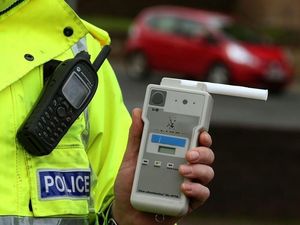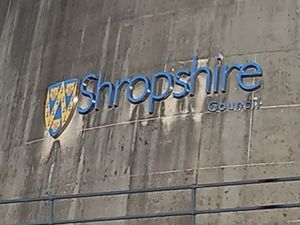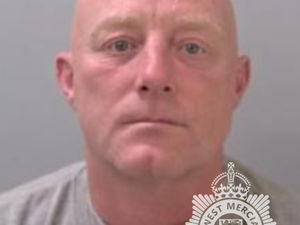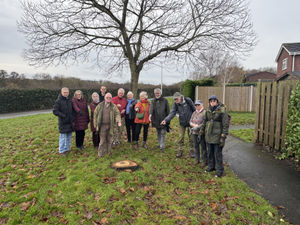Shrewsbury couple master the art of detection
What keeps someone digging for treasure for 10 years? For this Shrewsbury couple, it's all about the history, the excitement of the find and the interesting story behind the old objects they uncover in fields near their home.
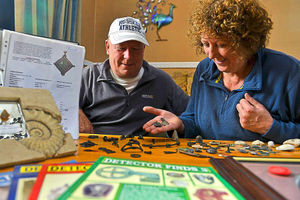
Sharon Edwards, 56 and her husband Russell, 60 have been metal detecting since about 2005 and have uncovered all sorts of historical items around their home in Meole Brace, Shrewsbury.
"It is the history, really," said Mrs Edwards.
"You find things and bring them home and it is the joy of looking them up and finding out what they are and what the history behind them is.

The county's fields have been the backdrop for some spectacular discoveries over the years with metal detectorists regularly uncovering pieces of history.
One of the largest saw 10,000 bronze Roman coins discovered in a field near Shrewsbury in 2009 all in cloth bags in a clay pot which are believed to have been buried about 1,700 years ago.
The hoard is thought to have belonged to a wealthy person or community and was buried for safekeeping, but it was unclear why they were not recovered.
The coins, mainly bronze nummi, were found in layers within the clay jar, with those at the top dating from between 333-335 AD, and the coins at the bottom at least 10 years older – suggesting the hoard had been added to over a number of years.
And the huge hoard is not the only group of coins uncovered in the county. Last week, an inquest heard a find of 90 Roman coins were seized by police in a south Shropshire man's bedroom. The hoard was made up of silver coins, 87 complete and three broken. Some are still with soil stuck to them and are believed to date back as early as 71 AD. The hoard was declared as treasure.
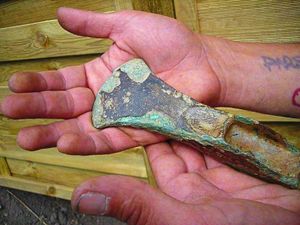
And in July 2013 metal detector enthusiasts struck discovered a hoard of 518 mixed Roman copper coins in three cloth bags, all put into a leather satchel and buried near Ludlow.
Hooks, brooches and axe-heads have also been unearthed by metal detectorists around the area. In May 2013 a rare D-shaped buckle or brooch was found in the Ludlow area believed to have been made in the late 13th or early 14th century.
Last November, a ring and hook thought to be more than 500 years old were found in Bridgnorth, both thought to be owned by "high-status people". The hook was found to be a Tudor dress hook or hat hook and the ring was known as a posy or posie ring with an inscription MY HART IS YOVRES written inside.
Metal detectorist Chris Langston has found a host of items in his back garden near Oswestry, including a 3,500-year-old Bronze Age axe head, coins from the time of Georges I, II and III, buckles, tap keys and silver love tokens engraved with initials.
Fellow detectorist Tony Baker found a gold ring with a tragic story behind it in a field near Bridgnorth in 2005. Inscribed were the names Mary and Sarah Littleton and the date June 7, 1735. It was made by Thomas Littleton in memory of his wife and child, who had died in childbirth.
"It is amazing to see what was going on in our area and how areas were used and what they are now."
Her husband said: "I think my favourite thing is it gets you out the house, it is a good hobby to get into and it is good exercise as well.
"It really is a nice feeling when you find stuff."
Mrs Edwards added: "It's like the town football pitch – it must have been a market or something of the sort. I know it was a used by the Romans but we have found things from the Romans all the way through to Victorian times. That has been a really important place at one time, and it is odd because in all the fields around it we have found nothing!"
Mrs Edwards said they had found numerous coins, brooches and farming artefacts as well at the site.
She said: "It must have been quite a place to be – but of course it is all gone now.
"We got into it because a friend had started. He brought something back that he had found and we couldn't work out what it was and it was so interesting.
"He had found a Roman statue and they couldn't trace where it was from – that was really interesting to us.
"We had a go and I remember my very first find was a Victorian penny.
"I was over the moon. Since then I have found all sorts.
"I think the most interesting was a Neolithic arrowhead and that was just by eye. It was flint and just lying on top of the soil.
"It is amazing to think that these people have been here shooting animals with bows and arrowheads."
Her husband had also been very successful with finds including a Roman intaglio stone that had been recycled in Medieval times into a seal which around the sides read "serve ye lord in fear".
Many of the couple's finds have ended up in local museums on show for people to see.
Mrs Edwards said: "He has also found a medieval hair pin which was on display as well.
"It is nice to have things you have found displayed. It is definitely better to share them for everyone to see.
"What good is it for one person to keep it for themselves?"
Sadly, there are a number of metal detector enthusiasts who do keep a lot to themselves.
Metal detector enthusiasts should get permission from landowners before they start looking, they should abide by any relevant laws and should report finds to their local finds liaison officer of the Portable Antiquities Scheme.
Mrs Edwards said: "The main problem we have got is people who go detecting but don't have permission from the landowner and don't fill in the holes they leave.
"If they find cans or rubbish, they just leave them rather than taking them off the field.
"It really has put us off going sometimes. We have always got permission and the handful of people that don't give us all a bad name.
"Night-hawkers go in the middle of the night and don't get permission.
"They come from all over if they know it is a good place, and they go through the night digging up and they don't tell anyone what they have found."
The couple now go out metal detecting a couple of times each week and stay within the Shrewsbury area.
"When you find something it really is an exciting and interesting feeling. It's all about perseverance," said Mrs Edwards.


